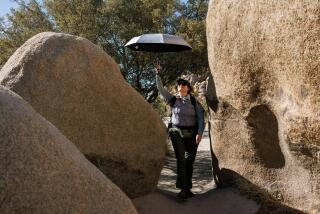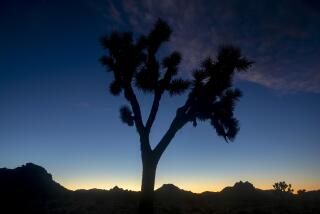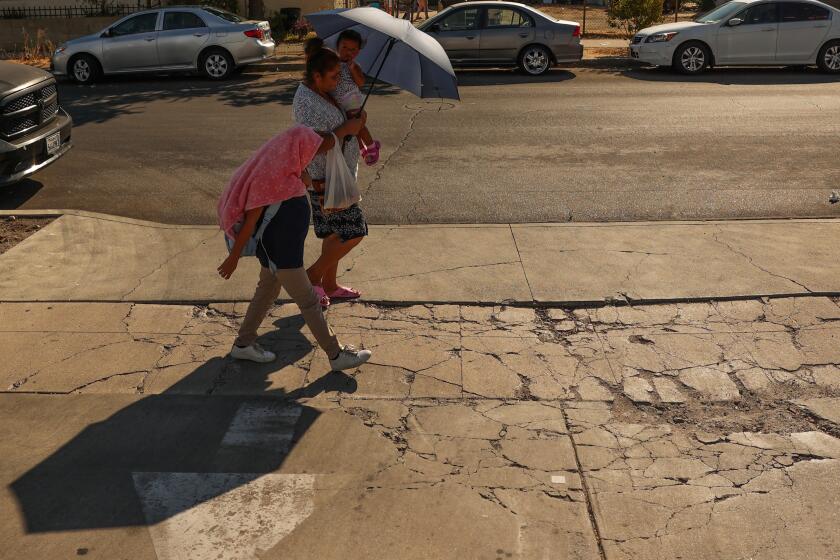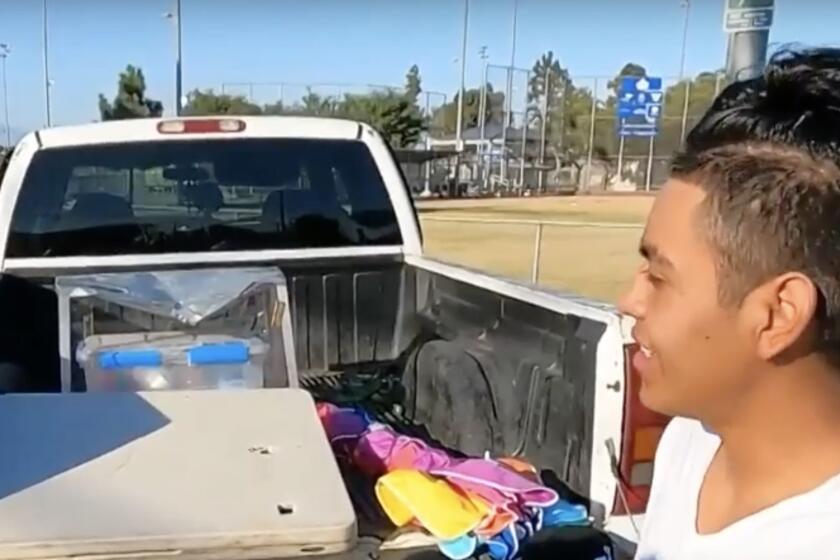Locals believe bobcat trappers are crossing the line in Joshua Tree
JOSHUA TREE — Annica Kreuter’s backyard on the edge of Joshua Tree National Park has been a perfect place to chronicle the adventures of eight bobcats.
Over the last decade she has watched a young bobcat chased up a tree by a coyote; an alpha male surveying the landscape from the hood of her car; a kitten sauntering into the yard as she gardens; a matron sniffing the back of Kreuter’s neck as she napped on a hammock.
Lately, seven of the eight have vanished. “At sunrise, I hear the one that is still here crying for his family,” Kreuter said.
She and others in this high desert community of about 8,000 say bobcats have been disappearing lately, killed for the value of their pelts by trappers who often trespass on private property. The trappers come armed with wire cages, squirt bottles of potent scent and bobcat lures: battery-powered vibrating pet toys festooned with feathers to resemble dying birds.
Hunting and trapping bobcats is legal during hunting season outside of the national park boundaries. But to the locals, that makes little difference. “The very idea of trapping in a place where bobcats are so well-known they have nicknames — Big Gray, Leroy, Tomboy — is disturbing and heartbreaking,” Kreuter said.
As one of the top predators of a 720,000-acre park visited by 1.4 million people each year, the bobcat’s presence — or absence — has a cascade of consequences, making it a governing force of the ecosystem and the local ecotourism economy. An adult bobcat stands about 15 inches high and can cover 25 to 30 miles of territory in a day. Using razor-sharp claws and powerful legs, it preys on rabbits and makes a significant contribution to rodent control.
Critics believe the trappers are after bobcats that routinely crisscross the invisible park boundary lines.
“This is really, really bad,” said astronomer and conservationist Tom O’Key, who was the first to discover a trap. “These guys are carpetbaggers coming onto private land to slaughter bobcats with no regard for a tight-knit community that cares deeply about the national park and its wildlife.”
O’Key alerted the community after finding a trap chained to a jojoba bush and camouflaged with broken branches and leaves on his property north of the park. He notified the San Bernardino County Sheriff’s Department and the Hi-Desert Star newspaper.
Bobcats are being targeted for the value of their pelts in top-dollar markets such as China, Russia and Greece. A premium pelt of heavily spotted white belly fur can earn a trapper more than $600, according to Nathan Brock, who skinned 10 bobcats that he captured in the Joshua Tree area during the hunting season that ended Jan. 31.
Brock, 38, an active-duty Marine stationed at nearby Twentynine Palms Marine Corps Base, acknowledged that one of his traps was set on private property and not on federal Bureau of Land Management grounds, where trapping is legal. The region is a patchwork of private property and BLM land.
“I feel horrible about that,” Brock said. “It’s my fault for not making sure.”
The manufacturer of Brock’s trap, Mercer Lawing of Barstow, said critics miss the point. “We love those animals more than the people who are complaining about us trapping them do,” Lawing said. “Nathan and I harvest adult male cats and turn loose adult females and kittens.”
The national park has taken a neutral position on the issue, given that its jurisdictional reach extends only as far as its boundaries.
However, park biologist Michael Vamstad said, “Residents have every right to be upset. The fact that there is no limit on bobcats that can be legally taken during hunting season doesn’t jibe along the edges of a national park. It’s a relic regulation.”
Conservationists are calling for a “no-trapping” buffer zone in the area because bobcats travel along a web of interconnected wildlife corridors stretching from the national park to the Marine base about 10 miles to the north.
“The law has to change if it’s legal for a handful of people to line the boundary of a national park with traps to catch bobcats, then send their pelts to China for profit,” said Brendan Cummings, public lands director for the Center for Biological Diversity. “We are not going to let this happen again.”
Equally pointed words came from Nancy Karl, executive director of the Mojave Desert Land Trust, a nonprofit dedicated to preserving safe passage for wildlife between protected areas. “We are watching and paying close attention — and we are going to change things,” Karl said. “Those trappers would be best advised to move it.”
More to Read
Sign up for Essential California
The most important California stories and recommendations in your inbox every morning.
You may occasionally receive promotional content from the Los Angeles Times.











